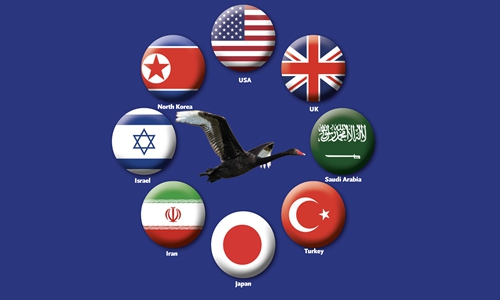
For the Chinese economy, 2020 is going to be another tough year, albeit not that bad as 2019, as hidden risks and pressure from many fronts accrue to bite.
Trade tensions with the US could still cast a dark shadow over the Chinese economy in 2020, even after Chinese and US officials have recently reached a phase one trade agreement, according to a list of black swan incidents this year published by Chimerica Communications, a Washington-based consultancy that focuses on Chinese companies.
Given the hostile approach from Washington toward Beijing, tensions between the world's two largest economies could linger and even escalate, with the tariff and technology war wading into more areas such as consumer goods and services, Chimerica said in the report.
Apart from slapping unilateral tariffs on hundreds of billions of dollars' worth of Chinese products, the US has also engaged in a global crackdown on Chinese technology firms and blatant interference in China's internal affairs.
Many Chinese analysts predict that tensions will linger even after the phase-one trade agreement is signed, which is reportedly set to be inked later this month. This year is also an election year when US politicians tend to be more hostile toward China.
Other potential black swan events in 2020 that could have some negative impact on the Chinese economy include persistent turmoil in Hong Kong, tensions between North Korea and the US and recession for the global economy, according to Chimerica. All these events may not be directly linked to the Chinese economy, but they could exert extra pressure, it said.
All these risks exist on top of domestic challenges already faced by the world's second-largest economy.
Domestically, one of the biggest challenges is employment, according to Liang Haiming, chairman of China Silk Road iValley Research Institute. "We need to resolve the jobs issues for about 12 million people this year," Liang told the Global Times on Wednesday.
Apart from jobs, persistent downward pressure from a structural transformation and declining trade due to a slowing global economy could also pose serious challenges for Chinese policymakers in 2020.
Still, Li Daxiao, chief economist at Shenzhen-based Yingda Securities, said that China still has many tools to stabilize growth in the face of all the risks and challenges. "There will be many policy measures in 2020," Li told the Global Times on Wednesday, referring to more fiscal spending and monetary ease.
"I think we could keep a 6 percent GDP growth this year, if all the policies are well implemented," Li said, adding that more measures are needed to help businesses, as they face difficulties in raising funds.
The People's Bank of China (PBC), China's central bank, announced on Wednesday that it would cut the reserve requirement ratio (RRR), cash that commercial banks are required to hold as reserves at the central bank, by 50 basis points starting on January 6 to boost market liquidity. This is the first RRR cut this year, but the eighth since early 2018.
In anticipating potential risks and challenges, Yi Gang, governor of the PBC, said in his New Year's remarks on Tuesday that China has the resolve and confidence to deal with potential black swan and grey rhino incidents, which are neglected threats that could have a huge impact.
Yi also stroke a more positive tone in the remarks. "In a world undergoing changes unprecedented in a century, both challenges and opportunities exist. It is more of an opportunity than a challenge," he said.

